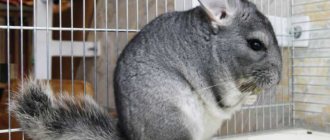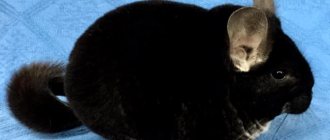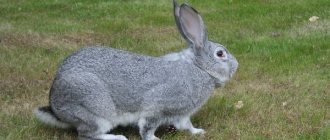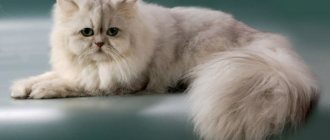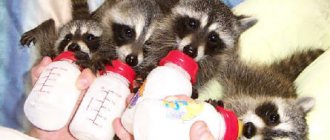08 December97861pet rodentschinchilla
The chinchilla animal is a rodent that inhabits the territory of South America. Chinchillas are known for their valuable fur, because of which their numbers have rapidly decreased and these animals are listed in the Red Book. Today the chinchilla animal is a very popular pet. Below you will find a description of the chinchilla, and you can also learn about the features of caring for and keeping a chinchilla at home.
Description of chinchilla
The chinchilla looks very cute and funny. The chinchilla animal has a large head, short neck and round body. She has large ears, a long mustache and a short tail. The chinchilla looks like a small rodent. Chinchillas range from 25 to 35 cm in length, with females being larger than males. The rodent weighs 500-700 grams.
The chinchilla looks fluffy, as if made of plush. She has soft, thick and beautiful fur. The chinchilla looks inconspicuous due to its gray-blue color and only on its belly its fur has a light gray tint. Modern colors of captive-bred chinchillas are varied and have many variations.
The description of the chinchilla includes many unusual facts about these rodents. For example, their ears have special membranes, with the help of which the animals close their ears during sand baths so that sand does not get inside. Chinchilla fur is very dense because up to 80 hairs grow from each hair follicle.
Thanks to the developed cerebellum, the chinchilla animal has good coordination and is adapted to night life. The animal's hind legs are longer than its front legs, which allows it to jump to a height of up to 2 meters. Chinchillas make many interesting sounds, they can quack, chirp, growl, squeak and click their teeth.
Natural enemies
Large predators are not found in chinchillas' habitats, but they still have plenty of enemies. First of all, these are foxes that set up ambushes near the burrows of furry rodents, and patiently wait for the prey to carelessly emerge from its hiding place. Snakes often sneak into the gorges favored by chinchillas, and owls and eagle owls lie in wait for them in the pre-dawn hours. Taira is also not averse to hunting them - a predator from the mustelid family, whose small size allows it to deftly penetrate into the chinchillas’ lair, grabbing the first animal it comes across.
Camouflage color helps chinchillas successfully hide from predators
But the most dangerous enemy for these amazing creatures was and remains man, who, because of their beautiful fur, almost completely exterminated chinchillas in their natural habitat.
Where and how long do chinchillas live?
Chinchillas live for about 20 years. The homeland of these animals is South America. Under natural conditions, the chinchilla lives in the Andes of Southern Bolivia, northwestern Argentina and northern Chile. Chinchillas live in the mountains at an altitude of up to 5 km above sea level. In its natural environment, the chinchilla animal lives in rock crevices, under stones, or digs holes.
The chinchilla animal is perfectly adapted to life in the mountains. The structure of the skeleton allows the animal to crawl through even the narrowest spaces, and the developed cerebellum ensures confident movement along rocks. Chinchillas live in colonies and are active at night. In nature, chinchillas feed on various herbaceous plants (cereals, beans, mosses, lichens, shrubs, cacti, tree bark) and insects.
The chinchilla animal is mostly monogamous. Chinchillas become capable of reproduction at the age of 7-8 months. The duration of pregnancy is a little more than 3 months. Usually 2-3 babies are born. The female is capable of bearing offspring up to three times a year. Chinchilla cubs are born with open eyes, erupted teeth and covered with primary hair.
It's no secret that the chinchilla animal is a source of valuable fur. Chinchillas began to be hunted for their beautiful fur in the 19th century. To make one fur coat, it takes about a hundred skins, so chinchilla fur products are rare and expensive. In 1928, a coat made from the fur of these rodents cost half a million gold marks. In 1992, the price of a chinchilla fur coat was $22,000. Currently, the chinchilla animal is protected in South America. Now in many countries there are special farms where chinchillas are bred for their fur.
Population and species status
Today we can safely say that these animals are facing complete extinction. This mainly concerns chinchilla populations in the wild. According to experts, over the past 15 years the total number of these animals has decreased by almost 90 percent. In 2022, scientists knew of only 42 colonies of animals living within the South American continent. Scientists also believe that there are so few animals left that there is no need to talk about an increase in the population.
Interesting moment! A chinchilla fur coat is valued at $20,000, so it’s not surprising that these animals are so mercilessly destroyed. To sew one fur coat, you will have to destroy at least a hundred adult individuals.
They began sewing such fur coats in Europe in the 19th century. From 1828 to 1916, about 7 million skins were exported from Chile, and in total up to 21 million animals were destroyed and exported. The figure is such that the hair on the head rises spontaneously. Only in 1898 were laws passed prohibiting hunting and export. Unfortunately, it was very late and such bans are no longer able to influence the decrease in the total number.
How to tame a chinchilla?
It is better to get a chinchilla when the animal is no more than 2-3 months old. At this age, the animal quickly adapts to a new environment than older individuals. If you decide to get a chinchilla, remember that this is a nocturnal animal that will be active in the evening and at night. The first time after the animal appears in the house, give it a few days of rest so that it gets used to its new home.
Taming a chinchilla is not that easy. For the most part, chinchillas do not need much attention and communication with their owner. Therefore, a chinchilla should be tamed gradually. Try giving your pet a treat, open the cage door and hand the chinchilla something tasty. The pet will definitely take the treat from your hands, if not immediately, then after a while. The main thing is not to try to forcibly pick up the animal.
To tame a chinchilla you will need patience, calmness and a caring attitude. Soon the tamed animal will be safely in your arms or sitting on your shoulder. Remember that by nature the chinchilla is a gentle, timid creature and does not like loud noises. Be careful when handling your chinchilla and do not frighten it.
Games and physical activity
These are very playful and active animals that simply love to walk around the apartment. A chinchilla will never miss an opportunity to sneak out of its cage and go explore the world. And considering that this is a rodent, after such entertainment for your pet you will find chewed shoes, sofa upholstery and wires. Also, an animal, frightened by a loud sound, can hide under a closet, from where it will be very difficult to get it out.
So experts do not recommend letting your chinchilla out of its cage, but rather purchasing a running wheel to satisfy its active needs. As a last resort, you can fence off an area on the floor in which your pet can frolic without causing damage to the apartment.
Chinchilla in a running wheel
What to feed your chinchilla?
Chinchillas are vegetarians, so when choosing food, you should take this feature of the animal into account. The chinchilla needs to be fed with special food. Pet stores have a huge range of granulated food. This food contains essential vitamins and minerals.
In addition to food, you must feed your chinchilla hay. You can prepare it yourself; for this you need to collect clover, dandelions and herbs. But you can also buy hay at a pet store. When purchasing, pay attention to the quality of the hay; it should be dry, clean, free of unpleasant odor and mold. A special hay feeder should be placed in the cage.
The chinchilla should be fed once a day. Food and water should always be fresh. Water should be given filtered or boiled. There should always be a special stone in the cage for grinding teeth, which can be purchased at any pet store.
Pelleted dry food and hay are the best diets for chinchillas. As a top dressing, you can give your chinchilla flax seeds, corn grains, dandelion leaves, birch, willow, raspberry, apple, currant and linden branches. But under no circumstances give branches of cherry, oak and coniferous trees. You should not feed your chinchilla many fresh vegetables and fruits, as this can lead to stomach problems.
Chinchillas especially love raisins, dried apricots, dried apples, pears, cherries and rose hips. But such treats should not be given often. Also be careful with nuts and seeds, they should be given in very limited quantities and only raw; fried grains are contraindicated for the animal. You should not give your chinchilla food from your own table (bread, cookies, etc.).
Care and maintenance of chinchillas at home
Keeping a chinchilla at home is no less popular than keeping a guinea pig. First of all, to keep a chinchilla you will need a spacious cage. It is better if the cage is of a tower type. The optimal solution in this case would be a display case for a chinchilla, which will be an excellent home for the animal and will fit well into the home interior. A display case for a chinchilla will satisfy all the needs of a rodent; it has a house, stairs, floors, balconies, a running wheel and other toys. In addition, cleaning in such a display case is even easier than in a cage.
Keeping a chinchilla requires maintaining a certain temperature. The chinchilla animal does not tolerate heat well, so the cage should be placed in a cool place, without direct sunlight and drafts. The optimal temperature for keeping a chinchilla will be +20-22 °C. At temperatures of +25 °C and above, the rodent will overheat. Never place the cage near batteries.
The bottom of the cage must be lined with sawdust or special filler. The animal goes to the toilet anywhere and it is very difficult to train a chinchilla to do it in one place. The litter will have to be changed at least once a week. It is better to hang the feeder and water bowl, otherwise the chinchilla may turn them into a toilet.
Caring for a chinchilla at home includes taking care of the rodent's coat. Chinchilla fur gets dirty very quickly, so the animal needs frequent hygiene procedures. But the chinchilla bathes not in water, but in special sand. Chinchillas take sand baths with diligence and sand will fly in all directions. Therefore, it is advisable to carry out this procedure outside the cage, so as not to collect sand later. The best option in this case would be a round aquarium or any other deep, stable, round-shaped container. Place it on the floor, lay newspaper under it, pour a 5-6 cm layer of sand on the bottom and put the animal there for 20-30 minutes.
Caring for a chinchilla at home includes bathing at least 2 times a week. If your home has high humidity and temperatures close to +25 °C, bathing should be done 3 times a week. Bathing is a must for an animal if you want your chinchilla to have beautiful fur. Do not forget that swimming in water is harmful to a chinchilla and will cause health problems.
Also remember that ordinary sand (sea, river) is not suitable for swimming. After all, in the wild, the chinchilla animal bathes in volcanic dust, and not in sand. Therefore, at home it is permissible to use only special sand. In addition, in ordinary sand, an animal can become infected with fungus, parasites or skin diseases. To prevent skin diseases, antifungal drugs can be added to special sand.
In general, caring for and maintaining a chinchilla at home does not require much effort. The main condition is to protect the animal from overheating and maintain the correct diet. Try not to leave the animal unattended outside the cage. Remember that rodents love to taste everything and you will be guaranteed damaged furniture. The main danger lies in electrical wires. Also, do not forget that any hard-to-reach space in the apartment will be immediately explored by a curious animal.
The chinchilla, the maintenance and care of which is quite simple, has a number of advantages and one disadvantage. The advantages include the small cost of the animal, beautiful appearance, lack of odor and shedding, and peaceful character. But the disadvantage is the nocturnal lifestyle. If you decide to get such an animal, you will have to get used to rustling, squeaking and fussing at night.
Chinchilla diseases
Chinchilla diseases are most often the result of improper care and poor nutrition. The most common problems are: gastrointestinal upset (usually due to low-quality or expired food, poor feeding habits or a monotonous diet), hair problems (the cause may be a lack of vitamins or skin parasites), obesity, bladder stones, conjunctivitis, periodontal disease , sunstroke or hypothermia.
If you have the slightest suspicion that your chinchilla has health problems, you should contact your veterinarian. It is extremely undesirable to delay visiting a doctor, because the sooner the problem is identified, the greater the chance of curing your pet.
Take care of your pets, take care of them and do not forget that we are responsible for those we have tamed. If you liked this article, subscribe to site updates to be the first to receive the most interesting and useful articles about animals.
Don’t forget to subscribe to updates on our website and join us on social networks (Vkontakte, Odnoklassniki, Instagram) so you don’t miss anything and always stay up to date with all the news!
Don't forget to share with your friends!

